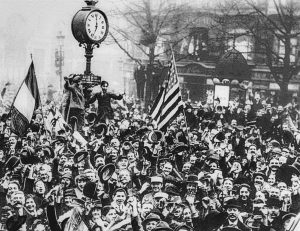Adam Hochschild in The New Yorker:
 For millions of soldiers, the First World War meant unimaginable horror: artillery shells that could pulverize a human body into a thousand fragments; immense underground mine explosions that could do the same to hundreds of bodies; attacks by poison gas, tanks, flamethrowers. Shortly after 8 p.m. on November 7, 1918, however, French troops near the town of La Capelle saw something different. From the north, three large automobiles, with the black eagle of Imperial Germany on their sides, approached the front lines with their headlights on. Two German soldiers were perched on the running boards of the lead car, one waving a white flag, the other, with an unusually long silver bugle, blowing the call for ceasefire—a single high tone repeated in rapid succession four times, then four times again, with the last note lingering.
For millions of soldiers, the First World War meant unimaginable horror: artillery shells that could pulverize a human body into a thousand fragments; immense underground mine explosions that could do the same to hundreds of bodies; attacks by poison gas, tanks, flamethrowers. Shortly after 8 p.m. on November 7, 1918, however, French troops near the town of La Capelle saw something different. From the north, three large automobiles, with the black eagle of Imperial Germany on their sides, approached the front lines with their headlights on. Two German soldiers were perched on the running boards of the lead car, one waving a white flag, the other, with an unusually long silver bugle, blowing the call for ceasefire—a single high tone repeated in rapid succession four times, then four times again, with the last note lingering.
By prior agreement, the three German cars slowly made their way across the scarred and cratered no man’s land between the opposing armies. When they reached the French lines, they halted, the German bugler was replaced by a French one (his bugle is in a Paris museum today), and the German peace envoys continued their journey. At La Capelle, flashes lit up the night as the envoys were photographed by waiting press and newsreel cameramen, then transferred to French cars. Their route took them past houses, factories, barns, and churches reduced to charred rubble, fruit trees cut down and wells poisoned by retreating German troops.
More here.
